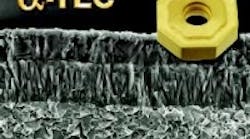Iscar’s TEC grade inserts incorporate innovative coatings for targeting specific machining and material applications.
Cutting tool substrates, coatings and edge preparations play a crucial part in efficient machining and often make or break a metal cutting operation. These elements, together with embedded chipbreaker and corner determine the suitability of cutting tool to a specific workpiece or application. The combination of these parameters guarantees the long tool economical machining and performance. That is the cutting tool makers target research and development substrates, coatings and preparations, when engineering inserts to meet increasing of machining applications the challenges of new for workpieces. the latest developments substrates involves tungsten
Tungsten-carbide tools hardness and toughness handling a wide range of cutting parameters, and cutting tool makers can actually tailor a substrate by altering the tungsten grain size within the range of one to five microns.
Finer grain sizes (submicron) provide more wear resistance to the tool. Conversely, larger grain sizes make for tougher tools. Fine-grain substrates are primarily used for inserts that cut aerospace materials such as titanium, Inconel and high-temperature alloys.
Besides altering the size of the grain in these tools, toolmakers have the option of altering the cobalt content in the substrates. Cobalt is used as a binder — the cement that holds the tungsten-carbide grains together. Increasing the cobalt content from the typical 6 percent to 12 percent provides greater toughness, allowing toolmakers to adjust a tool's content to meet the demands of any application, whether it requires toughness or wear resistance.
Toolmakers also can enhance substrate performance by adding an enriched cobalt layer adjacent to the outer surface, or by selectively including other types of alloying elements, such as titanium carbide (TiC), tantalum carbide (TaC), vanadium carbide (VC) and niobium carbide (NbC), to the tungsten-carbide composition. The enriched cobalt layer substantially boosts edge strength, improving performance for roughing and interrupted-cutting applications. Shops should keep in mind that five other properties of the substrate — fracture toughness, traverse rupture strength, compressive strength, hardness and thermal shock resistance — also are important when selecting the substrate to match the workpiece material and machining requirements.
Coatings
Cutting tool producer Iscar Metals Inc. (www.iscarmetals.com) says coating developments in recent years have led to growth in demand for PVD coated tools at the expense of CVD coated tools. While CVD coating thicknesses vary between 5 and 15 microns, PVD coating thicknesses range from two to six microns. CVD coatings also create tensile stress when applied on top of a substrate, while PVD coatings facilitate compression stress upon the substrate. Iscar says the differences between tensile stress and compression stress influence cutting-edge performance in continuous and interrupted machining. Developing new alloying elements in the coating process also assists in bonding coating layers, and improves coating properties.
Iscar's latest generation of coating technologies, that the company is marketing under the "Tec" name, have modified CVD and PVD coatings, and even combinations of the two, to produce cutting tools that match specific applications better. For steel applications, Iscar's -Tec grade offers a moderate temperature CVD TiCN coating that consists of a thick Al2O3 layer designed to improve wear resistance at high cutting speeds while having good thermal stability and resisting chipping and plastic deformation.
Conversely, for cast iron applications, Iscar developed a coating of AlTiN PVD. Called Al-Tec, this coating has a high aluminum content to provide heat resistance, and the company says its performance excels at low to medium cutting speeds under unstable machining conditions. Another Iscar coating for various grades of cast irons is Do-Tec. This has a TiAlN PVD coating over an MTCVD Al2O3 coating layer. The combination gives shops multiple benefits, such as high wear and chipping resistance, when using medium to high cutting speeds.
For the future, Iscar says it expects to see an upsurge in advanced plasma coatings and diamond-like carbon coatings applied on large-scale production. The company also says another growing innovative approach to coatings is single, multifunctional coating layers that will replace traditional, thick multilayer coatings. According to Iscar, single multifunctional layers are easily designed for a variety of tribological and mechanical properties. Lastly, Iscar points out that the growing pursuit of nanotechnology is fueling large-scale production of nanolayer-coating techniques that combine toughness, hardness, oxidation resistance and thermal stability.
Edge preparation
In many instances, edge preparation (honing) can be the difference between successful machining or failure, and applications dictate proper honing parameters. For instance, high speed finishing of steel requires a totally different edge preparation than the one used for roughing.
Generally, a substantial hone works for continuous turning, as well as for milling of most steels and cast irons. But for severe interrupted cuts, a heavy hone or a T-land edge is needed.
In contrast, inserts need small hones and sharp edges for machining stainless steels or high-temperature alloys because these materials have a tendency to generate builtup materials on cutting edges. Equally, these same sharp edges are a must for cutting aluminum.






